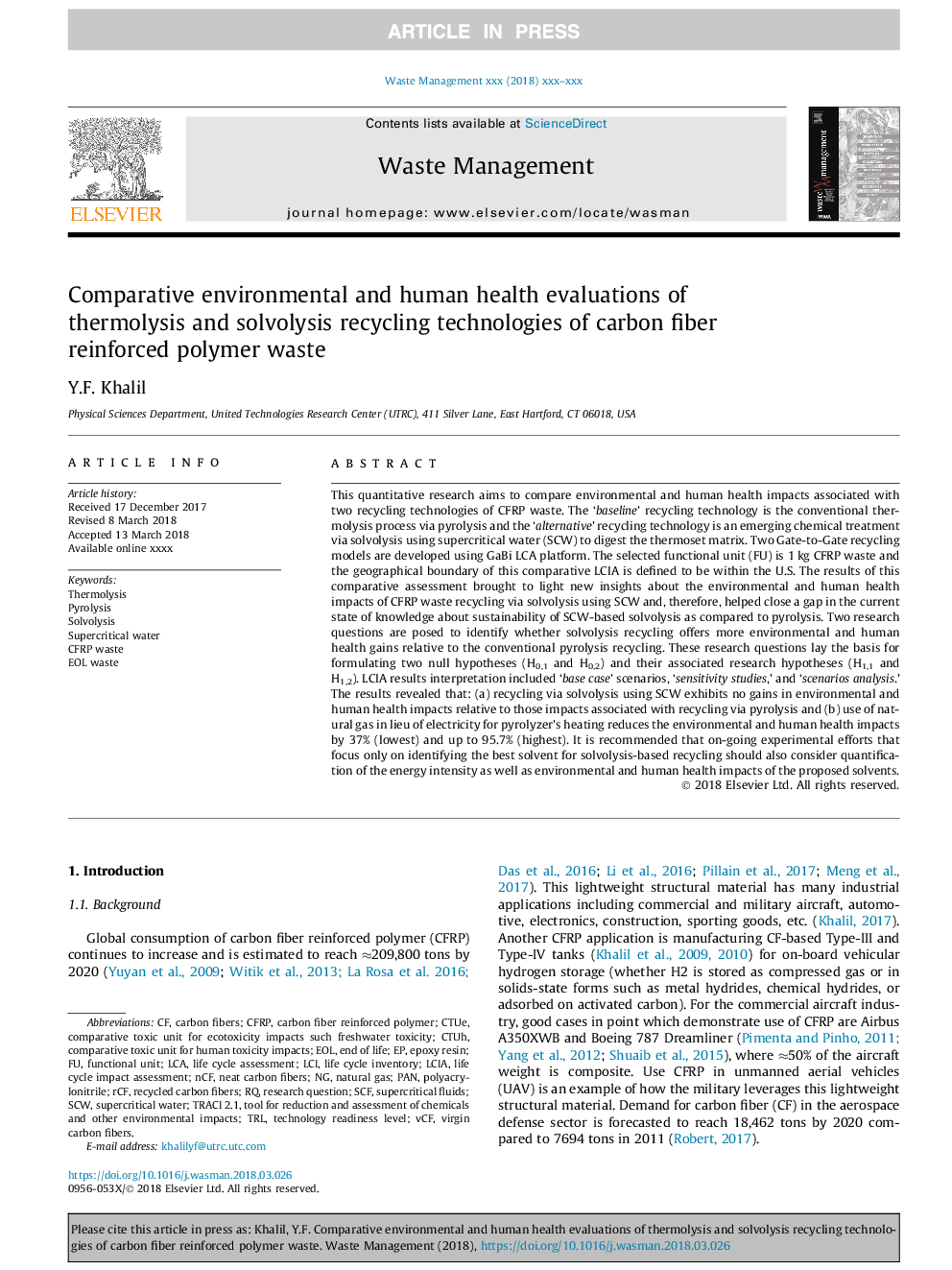| کد مقاله | کد نشریه | سال انتشار | مقاله انگلیسی | نسخه تمام متن |
|---|---|---|---|---|
| 8869772 | 1622610 | 2018 | 12 صفحه PDF | دانلود رایگان |
عنوان انگلیسی مقاله ISI
Comparative environmental and human health evaluations of thermolysis and solvolysis recycling technologies of carbon fiber reinforced polymer waste
ترجمه فارسی عنوان
ارزیابی های محیطی و سلامت انسان در مورد فن آوری ترمولیز و حلال حلزونی از زباله های پلیمری تقویت شده با فیبر کربن
دانلود مقاله + سفارش ترجمه
دانلود مقاله ISI انگلیسی
رایگان برای ایرانیان
کلمات کلیدی
NCFCTUhVCFLCIATRLSCFLCIRCFEOLSCWCFRPsupercritical water - آب فوق بحرانیLife cycle impact assessment - ارزیابی تاثیر چرخه زندگیLCA - ارزیابی چرخه حیاتLife Cycle Assessment - ارزیابی چرخه عمر یا چرخه حیاتCarbon fibers - الیاف کربنThermolysis - ترمولیزEpoxy resin - رزین اپوکسیTechnology Readiness Level - سطح آمادگی فنیSolvolysis - سلولیزresearch question - سوال پژوهشیPAN - ماهی تابهSupercritical fluids - مایعات فوق بحرانیLife Cycle Inventory - موجودی چرخه زندگیfunctional unit - واحد عملکردیend of life - پایان عمرPolyacrylonitrile - پلى اکریلونیتریلCarbon fiber reinforced polymer - پلیمر تقویت شده فیبر کربنPyrolysis - پیرولیز Natural gas - گاز طبیعی
موضوعات مرتبط
مهندسی و علوم پایه
علوم زمین و سیارات
مهندسی ژئوتکنیک و زمین شناسی مهندسی
چکیده انگلیسی
This quantitative research aims to compare environmental and human health impacts associated with two recycling technologies of CFRP waste. The 'baseline' recycling technology is the conventional thermolysis process via pyrolysis and the 'alternative' recycling technology is an emerging chemical treatment via solvolysis using supercritical water (SCW) to digest the thermoset matrix. Two Gate-to-Gate recycling models are developed using GaBi LCA platform. The selected functional unit (FU) is 1â¯kg CFRP waste and the geographical boundary of this comparative LCIA is defined to be within the U.S. The results of this comparative assessment brought to light new insights about the environmental and human health impacts of CFRP waste recycling via solvolysis using SCW and, therefore, helped close a gap in the current state of knowledge about sustainability of SCW-based solvolysis as compared to pyrolysis. Two research questions are posed to identify whether solvolysis recycling offers more environmental and human health gains relative to the conventional pyrolysis recycling. These research questions lay the basis for formulating two null hypotheses (H0,1 and H0,2) and their associated research hypotheses (H1,1 and H1,2). LCIA results interpretation included 'base case' scenarios, 'sensitivity studies,' and 'scenarios analysis.' The results revealed that: (a) recycling via solvolysis using SCW exhibits no gains in environmental and human health impacts relative to those impacts associated with recycling via pyrolysis and (b) use of natural gas in lieu of electricity for pyrolyzer's heating reduces the environmental and human health impacts by 37% (lowest) and up to 95.7% (highest). It is recommended that on-going experimental efforts that focus only on identifying the best solvent for solvolysis-based recycling should also consider quantification of the energy intensity as well as environmental and human health impacts of the proposed solvents.
ناشر
Database: Elsevier - ScienceDirect (ساینس دایرکت)
Journal: Waste Management - Volume 76, June 2018, Pages 767-778
Journal: Waste Management - Volume 76, June 2018, Pages 767-778
نویسندگان
Y.F. Khalil,
